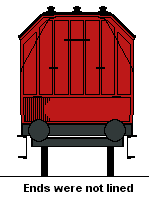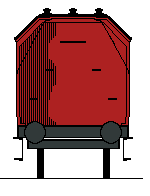|
A SHORT HISTORY OF THE NSW “DOGBOX” COMPARTMENT CARS Updated 13th January 2000
As an active modeller one of the problems I often have with the histories written from the view of the average railway historian is that these histories, excellent as they often are, sometimes don't tell the modeller what we really need to know, and that is what the rolling stock or infrastructure being described actually looked like! This page is an attempt to show the various stages that the appearance of the “Dogbox” carriages passed through in their long years of service on the railways of NSW and some notes on typical train compositions that included Dogboxes. The excellent talks by John Beckhaus given at the Modelling the Railways of NSW Conventions in 1996 and 1997 on “The Life and Times of the Express Lavatory Car” and “The Painting and Varnishing of Passenger Cars in NSW”, respectively, have been comprehensively mined for information to support the illustrations in this section. Thanks John, you made life so much easier! Now, of course, after many years of waiting, we finally have "Coaching
Stock of the NSW Railways" and the history and appearance changes of the
Dogbox cars are much easier to follow! Thanks once more to
John (Beckhaus) and his fellow authors, David Cooke, Don Estell and Keith
Seckold. One must not forget the excellent illustrations by Dennis
Toohey either, though its a pity the producers of the book choose to reproduce
them so small and to such variable scales.
A BRIEF OVERVIEW OF THE “EXPRESS LAVATORY” PASSENGER CARS OF THE NSW. Like most British influenced railway systems the NSWR made much use of non corridor compartment carriages and the cars of this series were known universally on the system as “Dogboxes”. Their official title was “Express Lavatory”, as they were designed to provide more comfortable accommodation on the express trains of the late 19th century than the existing fleet of carriages, and due to the distances traversed in NSW, the provision of accessible lavatories was a very welcome advancement for the long suffering traveller. The first series of "Dogboxes" entered service during 1890-91 and were all constructed on a standard 46ft underframe. The series consisted of : 50 FX Second class cars 30 BC First class cars 18 AJ Composite branchline cars with sleeping accommodation 18 HA Guard's vans Despite their official description as "Express Lavatory" vehicles only some of the First class compartments in the BCs, the Sleeping compartments in the AJs and the HAs were actually provided with toilets! The vast majority of this series of "Dogboxes" were rebuilt as L type tourist cars during the late 1920s, except for some of the AJs, which were converted to various designs of composite/Guard's vehicles, all coded HS, which survived into the 1960s and the HAs, of which some 21 were converted to the HO code by the removal of the toilet compartments between 1907 and 1909. Some of the HOs survived as Guard's vans into the 1950s and as ways and works vehicles till the early 1980s. Then, in 1897, the first of the second series of Dogboxes made their appearance. They consisted of:- 221 LFX Second Class Cars 107 BX First Class Cars 105 CX Composite First and Second Class Cars 53 EHO Guard's Vans
This second batch of Dogbox cars was built in three roof styles, Mansard
Low Semi-Elliptical
High Semi-Elliptical
There were also two further types of High Semi-Elliptical roofs used on EHO Guard's Vans only. These carriages formed the backbone of NSWR country services for
many years and up to the delivery of the FS and BS cars in the late 1930
trains consisting completely of Dogboxes were common. Even into the
fifties Dogboxes could be found "strengthening" many passenger trains from
the lowliest outer suburban train, through the short distance country trains,
the overnight Mails and even, on occasions, the air conditioned Daylight
services. In the early 1930s many were converted to R cars and a
batch of the later BXs were rebuilt to ACM Composite Sleeping Cars, however
this still left a large number of Dogboxes still valiantly soldiering on
till scrapping started in earnest in the late 1950s and early 1960s.
COLOUR SCHEMES CARRIED BY THE DOGBOX CARRIAGES While I have endeavoured to get the shades of colour in this guide as close as possible to what I think the originals were, the limitations of computer colour reproduction means that these illustrations should not be used for colour matching, but rather as guides to the general arrangements of the schemes and their lining out styles. PURPLE BROWN, 1897-1920s
PRE-WAR RUSSET AND TUSCAN RED, 1920-1946
KHARKI GREEN, 1942
High Semi-elliptical Roof :- LFX 728, 1648,
1650, 1735, 1971, 1642, 1845, 1973, 2069,
Cove Roof :- CX 1519, 1520
No Mansard roofed vehicles were painted in
this scheme.
POST-WAR TUSCAN AND RUSSET, 1946-1954
DEEP INDIAN RED, 1954-1982
|





 As
far as can be ascertained from this distance in time, Purple Brown, lined
out in Gold or Buff and with a White Lead roof was the standard NSWR passenger
car colour scheme from 1874 till 1920. Of course, not all cars were
repainted in the new livery in 1920 and cars in this scheme would have
lasted into the 1930s, and perhaps even longer. An intriguing colour
photo of a train on Cowan bank in Ron Selems' book, "Steam in the Fifties"
suggests that it is possible that at least one "Dogbox" lasted in this
scheme till the mid '50s.
As
far as can be ascertained from this distance in time, Purple Brown, lined
out in Gold or Buff and with a White Lead roof was the standard NSWR passenger
car colour scheme from 1874 till 1920. Of course, not all cars were
repainted in the new livery in 1920 and cars in this scheme would have
lasted into the 1930s, and perhaps even longer. An intriguing colour
photo of a train on Cowan bank in Ron Selems' book, "Steam in the Fifties"
suggests that it is possible that at least one "Dogbox" lasted in this
scheme till the mid '50s.

 This is a
speculative illustration based on the b&w photograph of a "Dogbox"
at Orange in 1933 on p55 in "Byways of Steam", Encore edition, that can
be interpreted to indicate that a panelled vehicle is painted in a two
tone colour scheme. Logically, once the new Russet and red colour
scheme was introduced in 1920, carriages that still had the old style panelling
would have been repainted in the new scheme.
This is a
speculative illustration based on the b&w photograph of a "Dogbox"
at Orange in 1933 on p55 in "Byways of Steam", Encore edition, that can
be interpreted to indicate that a panelled vehicle is painted in a two
tone colour scheme. Logically, once the new Russet and red colour
scheme was introduced in 1920, carriages that still had the old style panelling
would have been repainted in the new scheme.

 The Russet
and Red colour scheme, fully lined out in buff, was introduced in 1920,
and over the next couple of years, most, if not all, the "Dogboxes" that
had not been converted to R cars, would have carried this scheme.
The last cars to carry this scheme are believed to have lasted till the
early to mid '50s. The roof treatment changed from the older "White
Lead" treatment to a newer method known as "Navy Dressing", which was a
yellowy brown colour. Of course, the roofs did not stay clean and
colourful for long, soon weathering to a sooty brown/black colour.
The Russet
and Red colour scheme, fully lined out in buff, was introduced in 1920,
and over the next couple of years, most, if not all, the "Dogboxes" that
had not been converted to R cars, would have carried this scheme.
The last cars to carry this scheme are believed to have lasted till the
early to mid '50s. The roof treatment changed from the older "White
Lead" treatment to a newer method known as "Navy Dressing", which was a
yellowy brown colour. Of course, the roofs did not stay clean and
colourful for long, soon weathering to a sooty brown/black colour.

 During
1942 a number of carriages were painted Khaki Green with two horizontal
buff lines. "Dogboxes" known to have carried this scheme include;
During
1942 a number of carriages were painted Khaki Green with two horizontal
buff lines. "Dogboxes" known to have carried this scheme include;

 From 1946
a new standard colour scheme was introduced for all non varnished cars,
it was similar to the pre-war Russet and Red scheme, but the elaborate
lining out was replaced with two 1/2 inch buff lines, above and below the
windows. While the both the pre-war and post-war reds are described
in official correspondence as "Tuscan Red", I believe that the shades may
have been different, as I have seen a couple of O gauge models that were
constructed in the 1930s that depict the red as much darker than the post-war
shade. As the only evidence I have seen that indicates this cannot
be regarded as completely reliable, this, for the moment, remains speculation.
Many "Dogboxes" carried Tuscan and Russet till they were either scrapped
or converted to Ways and Works use.
From 1946
a new standard colour scheme was introduced for all non varnished cars,
it was similar to the pre-war Russet and Red scheme, but the elaborate
lining out was replaced with two 1/2 inch buff lines, above and below the
windows. While the both the pre-war and post-war reds are described
in official correspondence as "Tuscan Red", I believe that the shades may
have been different, as I have seen a couple of O gauge models that were
constructed in the 1930s that depict the red as much darker than the post-war
shade. As the only evidence I have seen that indicates this cannot
be regarded as completely reliable, this, for the moment, remains speculation.
Many "Dogboxes" carried Tuscan and Russet till they were either scrapped
or converted to Ways and Works use.

 From 1954
the standard NSW scheme was changed to an overall red, but retaining the
two 1/2 inch buff lines of the previous scheme. Described in official
correspondence as "Deep Indian Red", it was, despite the popular misconception
that the 1946 and 1954 reds were both "Tuscan Red", definitely a different
red to the red used in the Tuscan and Russet scheme. The post '54
Deep Indian Red was much darker and tended towards the blue/brown end of
the spectrum. This is clear from the study of colour photos and colour
samples. The last remaining restored examples of these cars are painted
in this scheme. At about this time a new roofing material, Malthoid,
was introduced, a bitumous material that was laid over the roof in wide
sheets. This was painted silver when new, but soon weathered to the traditional
sooty brown/black.
From 1954
the standard NSW scheme was changed to an overall red, but retaining the
two 1/2 inch buff lines of the previous scheme. Described in official
correspondence as "Deep Indian Red", it was, despite the popular misconception
that the 1946 and 1954 reds were both "Tuscan Red", definitely a different
red to the red used in the Tuscan and Russet scheme. The post '54
Deep Indian Red was much darker and tended towards the blue/brown end of
the spectrum. This is clear from the study of colour photos and colour
samples. The last remaining restored examples of these cars are painted
in this scheme. At about this time a new roofing material, Malthoid,
was introduced, a bitumous material that was laid over the roof in wide
sheets. This was painted silver when new, but soon weathered to the traditional
sooty brown/black.

